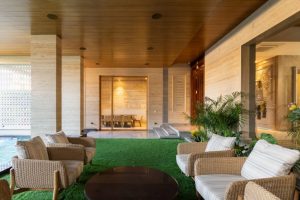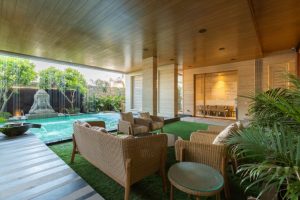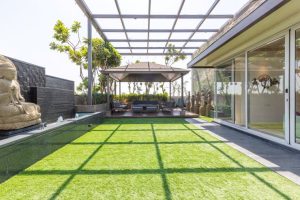Beyond waterproofing: Passive cooling, & natural drainage in tropical architecture

Rajkumar Kumawat
In tropical regions, the climate oscillates between heavy monsoons and intense solar exposure. Here, architecture must be resilient enough to meet these oscillations. It must breathe, adapt, and respond to the rhythms of nature. While waterproofing remains a fundamental necessity, it is no longer the only metric of climate resilience. A new paradigm in tropical architecture embraces passive cooling techniques, the reintroduction of courtyards as thermal moderators, and the integration of natural drainage systems into the very core of built environments. In this article, we explore monsoon strategies that go beyond waterproofing.
Courtyards Serving as Functional Design
Courtyards in tropical architecture serve as the lungs of the space. They release trapped heat, draw in air, and maintain a comfortable atmosphere. Courtyards create shaded internal pockets that remain cooler than the periphery of the building. The mass of the surrounding walls and the vegetative elements within them further stabilise internal temperatures, making mechanical cooling systems supplementary. A courtyard facilitates this vertical thermal movement by offering an outlet for hot air to escape, thereby drawing in cooler air from adjacent shaded openings. This “stack effect” enables continuous air circulation without the use of energy-consuming HVAC systems.
Passive Cooling & Designing with Climate
Tropical architecture has been inherently passive. Buildings were designed with an acute sensitivity to orientation, wind patterns, and solar movement. Aligning structures to harness prevailing breezes is fundamental. In coastal regions, buildings are often oriented to maximise cross-ventilation, using window placement and floor layouts that facilitate uninterrupted airflow. Deep overhangs, pergolas, and jalis shield walls and windows from direct sun exposure. Shading prevents heat gain and reduces glare, enabling interior spaces to remain cool without compromising natural light.
Natural Drainage & Rainwater Harvesting
In urban areas, drainage eliminates water, leading to flash floods and groundwater depletion. Hence, opting for natural drainage can alter this process. Replacing concrete with permeable pavers, gravel paths, and grassed areas allows rainwater to seep into the ground. Bioswales channel surface runoff into retention areas, filtering pollutants and recharging aquifers. Additionally, rain gardens are aesthetically integrated, bowl-shaped landscape features designed to collect runoff from roofs and hardscapes. Combined with underground recharge pits, they help retain rainwater on-site, promoting a self-sufficient water cycle.
Challenges and Opportunities
Even with the greatest technologies, challenges still persist in the environment. Urban densification often limits the space required for courtyards and natural drainage. Lack of regulatory incentives for passive cooling features in building codes poses a restraint. Higher initial design and planning effort compared to conventional approaches. But, on the same side, increasing awareness of energy efficiency and water scarcity is driving demand for climate-sensitive design.
Tropical architecture, when conceived holistically, rises above waterproofing as a mere technical requirement. It becomes a language of coexistence with climate, culture, and community. When implemented appropriately, it can result in a sustainable design.
Ar. Rajkumar Kumawat is Founder and Principal Architect at Rajkumar Architects




